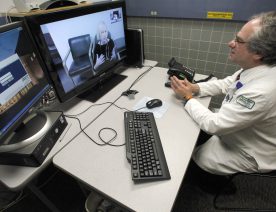
July 5, 2022
The lives of most adults in America remain different than they were before the pandemic. While not everyone expects to regularly use services accelerated by COVID-19 like curbside pickup, grocery delivery, telehealth, or reduced-capacity “senior hours” once the pandemic ends, many have gained familiarity with them and think it is a good thing that these changes may remain available as options in daily life.
A new study from The Associated Press-NORC Center for Public Affairs Research and The SCAN Foundation finds that just 12% of adults feel that their lives are completely the same today as they were before the pandemic, 54% feel their lives are somewhat the same, and 34% are not yet the same. Fifty-six percent of those whose lives are completely the same think that is a good thing, while 39% of those whose lives are not yet the same feel that is a bad thing.
More than half remain at least somewhat concerned about COVID-19 infection, and even if the perceived importance of wearing a mask has waned for some adults, many think steps like vaccination and effective treatments remain critical to participating fully in public life. To get back to pre-pandemic life, 51% feel it is essential to be vaccinated and 50% consider the availability of effective treatments to be essential. Just 22% feel regular indoor masking is vital.
Despite few reporting that their lives are completely the same, majorities have resumed activities they regularly did before the pandemic. Among those who did each at least monthly pre-pandemic, more than three-quarters expect to socialize with friends or neighbors in person (87%), go out to a bar or restaurant (79%), visit with older relatives in person (79%), travel (79%), and attend in-person religious services (79%) in the next few weeks. About two-thirds also expect to exercise at a gym or studio (65%) and participate in in-person community organizations (64%). Just half, however, expect to use public transportation (50%).
Groups of people that have been disproportionately impacted by the pandemic express more reservations about returning to public life. In particular, Hispanic adults are more likely than white adults to express concerns about the virus, and they are less likely to be resuming activities like socializing with friends or neighbors in person (77% vs. 92%) or go out to eat at a bar or restaurant (63% vs. 86%). Black and Hispanic adults are both more likely than white adults to think it is essential or important for most people to regularly wear face masks in public indoor spaces (78% and 62%, respectively, vs. 44%) or that most people are regularly tested for COVID-19 (71% and 58%, respectively, vs. 42%) for them to fully return to public life.
Use of services like curbside pickup, working from home, reduced capacity ‘senior hours,’ and telehealth increased for many during the pandemic. And more think it would be a good thing rather than a bad thing if many of these pandemic-related shifts like telehealth options (48% vs. 18%), more remote work (54% vs. 14%), and virtual options for community events (54% vs. 13%) continued after the pandemic ends.
Still, many expect to leave behind some of the ways of pandemic life: more than half think it is unlikely they personally will do things like have groceries delivered (66%), attend virtual activities (62%), shop during senior hours (62% of those age 60 and older), and receive care through telehealth (52%) once the pandemic is over.
While COVID-19 continues to pose a greater threat to the health of older adults, those age 18-49 and those age 50 and older show similarly low levels of concern about being infected with the virus. Those age 50 and older are just as likely as younger adults to report that their lives are the same as before the pandemic, and that they have resumed many of their routine activities like visiting with friends and family, traveling, and going out to bars or restaurants.
Although many changes brought by the pandemic like increased access to telehealth, grocery delivery, and expanded use of delivery and curbside pickup options by businesses should make it easier for older adults to age in their community, those age 50 and older are less likely to report that they will continue using these services after the pandemic ends. But older and younger adults were just as likely to have used these things during the pandemic, and older adults are just as likely as younger adults to think things like more people working remotely, more care provided through telehealth, and virtual options for social activities are good things rather than bad.
A third of the public feels like life has yet to return to its pre-pandemic state. These people are more concerned about the virus and are more likely to cite the need for effective treatments and vaccination against COVID-19 as essential to fully returning to public life. They also remain less likely to have resumed some of their regular activities like socializing with friends or older relatives. They are more likely to have increased their use of several services that became more common among all adults during the pandemic and are more likely to say they will use them after the pandemic ends. But they are not any more likely to say these are positive changes than other adults.

The AP-NORC Center conducted this study with funding from The SCAN Foundation (TSF). The survey includes 1,001 interviews with a nationally representative sample of adults living in America using the AmeriSpeak® Panel, the probability-based panel of NORC at the University of Chicago. Interviews were conducted between May 12-16, 2022, via web and phone in English. The margin of sampling error is +/- 4.0 percentage points.
- Suggested Citation: The AP-NORC Center for Public Affairs Research. (June, 2022). “Americans’ Readiness to Emerge from the Pandemic and Changes to Daily Life” [https://apnorc.org/projects/americans-readiness-to-emerge-from-the-pandemic-and-changes-to-daily-life/]









